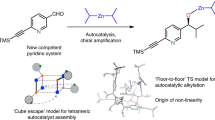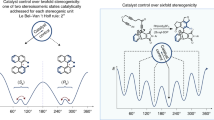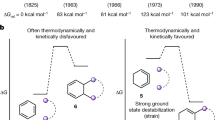Abstract
Conformational control of organic reactions is at the heart of the biomolecular sciences. To achieve a particular reactivity, one of many conformers may be selected, for instance, by a (bio)catalyst, as the geometrically most suited and appropriately reactive species. The equilibration of energetically close-lying conformers is typically assumed to be facile and less energetically taxing than the reaction under consideration itself: this is termed the ‘Curtin–Hammett principle’. Here, we show that the trans conformer of trifluoromethylhydroxycarbene preferentially rearranges through a facile quantum-mechanical hydrogen tunnelling pathway, while its cis conformer is entirely unreactive. Hence, this presents the first example of a conformer-specific hydrogen tunnelling reaction. The Curtin–Hammett principle is not applicable, due to the high barrier between the two conformers.
This is a preview of subscription content, access via your institution
Access options
Subscribe to this journal
Receive 12 print issues and online access
$259.00 per year
only $21.58 per issue
Buy this article
- Purchase on Springer Link
- Instant access to full article PDF
Prices may be subject to local taxes which are calculated during checkout





Similar content being viewed by others
References
Assion, A. et al. Control of chemical reactions by feedback-optimized phase-shaped femtosecond laser pulses. Science 282, 919–922 (1998).
Kim, M. H., Shen, L., Tao, H., Martinez, T. J. & Suits, A. G. Conformationally controlled chemistry: excited-state dynamics dictate ground-state reaction. Science 315, 1561–1565 (2007).
Choi, K.-W., Ahn, D.-S., Lee, J.-H. & Kim, S. K. A highly conformationally specific α- and β-Ala+ decarboxylation pathway. Chem. Commun. 1041–1043 (2007).
Zuev, P. S., Sheridan, R. S., Sauers, R. R., Moss, R. A. & Chu, G. Conformational product control in the low-temperature photochemistry of cyclopropylcarbenes. Org. Lett. 8, 4963–4966 (2006).
Khriachtchev, L. et al. Conformation-dependent chemical reaction of formic acid with an oxygen atom. J. Phys. Chem. A 113, 8143–8146 (2009).
Park, S. T., Kim, S. K. & Kim, M. S. Observation of conformation-specific pathways in the photodissociation of 1-iodopropane ions. Nature 415, 306–308 (2002).
Khriachtchev, L., Pettersson, M. & Räsänen, M. Conformational memory in photodissociation of formic acid. J. Am. Chem. Soc. 124, 10994–10995 (2002).
Ley, D., Gerbig, D. & Schreiner, P. R. Tunnelling control of chemical reactions—the organic chemist's perspective. Org. Biomol. Chem. 10, 3781–3790 (2012).
Kästner, J. Theory and simulation of atom tunneling in chemical reactions. WIREs Comput. Mol. Sci. 4, 158–168 (2014).
Borden, W. T. Reactions that involve tunneling by carbon and the role that calculations have played in their study. WIREs Comput. Mol. Sci. 6, 20–46 (2016).
Kohen, A., Cannio, R., Bartolucci, S. & Klinman, J. P. Enzyme dynamics and hydrogen tunnelling in a thermophilic alcohol dehydrogenase. Nature 399, 496–499 (1999).
Masgrau, L. et al. Atomic description of an enzyme reaction dominated by proton tunneling. Science 312, 237–241 (2006).
Layfield, J. P. & Hammes-Schiffer, S. Hydrogen tunneling in enzymes and biomimetic models. Chem. Rev. 114, 3466–3494 (2014).
Zuev, P. S. et al. Carbon tunneling from a single quantum state. Science 299, 867–870 (2003).
Schreiner, P. R. et al. Methylhydroxycarbene: tunneling control of a chemical reaction. Science 332, 1300–1303 (2011).
Ley, D., Gerbig, D., Wagner, J. P., Reisenauer, H. P. & Schreiner, P. R. Cyclopropylhydroxycarbene. J. Am. Chem. Soc. 133, 13614–13621 (2011).
Schreiner, P. R. et al. Capture of hydroxymethylene and its fast disappearance through tunnelling. Nature 453, 906–909 (2008).
Krueger, P. J. & Mettee, H. D. Spectroscopic studies of alcohols III. Fundamental OH stretching bands of 2,2-di- and 2,2,2-tri-haloethanols. Can. J. Chem. 42, 340–346 (1964).
Glendening, E. D., Landis, C. R. & Weinhold, F. Natural bond orbital methods. WIREs Comput. Mol. Sci. 2, 1–42 (2012).
Bader, R. F. W. Atoms in molecules. Acc. Chem. Res. 18, 9–15 (1985).
Barbarich, T. J., Rithner, C. D., Miller, S. M., Anderson, O. P. & Strauss, S. H. Significant inter- and intramolecular O−H···F−C hydrogen bonding. J. Am. Chem. Soc. 121, 4280–4281 (1999).
Razavy, M. Quantum Theory of Tunneling (World Scientific, 2003).
Ley, D., Gerbig, D. & Schreiner, P. R. Tunneling control of chemical reactions: C–H insertion versus H-tunneling in tert-butylhydroxycarbene. Chem. Sci. 4, 677–684 (2013).
Kästner, J. Path length determines the tunneling decay of substituted carbenes. Chem. Eur. J. 19, 8207–8212 (2013).
Seeman, J. I. Effect of conformational change on reactivity in organic chemistry. Evaluations, applications, and extensions of Curtin–Hammett/Winstein–Holness kinetics. Chem. Rev. 83, 83–134 (1983).
Oki, M. Reactivity of conformational isomers. Acc. Chem. Res. 17, 154–159 (1984).
Amiri, S., Reisenauer, H. P. & Schreiner, P. R. Electronic effects on atom tunneling: conformational isomerization of monomeric para-substituted benzoic acid derivatives. J. Am. Chem. Soc. 132, 15902–15904 (2010).
Pettersson, M., Maçôas, E. M. S., Khriachtchev, L., Fausto, R. & Räsänen, M. Conformational isomerization of formic acid by vibrational excitation at energies below the torsional barrier. J. Am. Chem. Soc. 125, 4058–4059 (2003).
Reva, I., Nunes, C. M., Biczysko, M. & Fausto, R. Conformational switching in pyruvic acid isolated in Ar and N2 matrixes: spectroscopic analysis, anharmonic simulation, and tunneling. J. Phys. Chem. A 119, 2614–2627 (2015).
Schreiner, P. R. et al. Domino tunneling. J. Am. Chem. Soc. 137, 7828–7834 (2015).
Halasa, A. et al. Three conformers of 2-furoic acid: structure changes induced with near-IR laser light. J. Am. Chem. Soc. 119, 1037–1047 (2015).
Domanskaya, A., Marushkevich, K., Khriachtchev, L. & Räsänen, M. Spectroscopic study of cis-to-trans tunneling reaction of HCOOD in rare gas matrices. J. Chem. Phys. 130, 154509 (2009).
Mackenzie, R. B., Dewberry, C. T. & Leopold, K. R. The formic acid–nitric acid complex: microwave spectrum, structure, and proton transfer. J. Phys. Chem. A 118, 7975–7985 (2014).
Tsuge, M. & Khriachtchev, L. Tunneling isomerization of small carboxylic acids and their complexes in solid matrixes: a computational insight. J. Chem. Phys. A 119, 2628–2635 (2015).
Maçôas, E. M. S., Khriachtchev, L., Pettersson, M., Fausto, R. & Räsänen, M. Rotational isomerism of acetic acid isolated in rare-gas matrices: effect of medium and isotopic substitution on IR-induced isomerization quantum yield and cis→trans tunneling rate. J. Chem. Phys. 121, 1331–1338 (2004).
Maçôas, E. M. S. et al. Infrared-induced conformational interconversion in carboxylic acids isolated in low-temperature rare-gas matrices. Vib. Spectrosc. 34, 73–82 (2004).
Pettersson, M. et al. Cis→trans conversion of formic acid by dissipative tunneling in solid rare gases: influence of environment on the tunneling rate. J. Chem. Phys. 117, 9095–9098 (2002).
Bazsó, G., Góbi, S. & Tarczay, G. Near-infrared radiation induced conformational change and hydrogen atom tunneling of 2-chloropropionic acid in low-temperature Ar matrix. J. Phys. Chem. A 116, 4823–4832 (2012).
Bazsó, G., Magyarfalvi, G. & Tarczay, G. Tunneling lifetime of the ttc/VIp conformer of glycine in low-temperature matrices. J. Phys. Chem. A 116, 10539–10547 (2012).
Bazsó, G., Najbauer, E. E., Magyarfalvi, G. & Tarczay, G. Near-infrared laser induced conformational change of alanine in low-temperature matrixes and the tunneling lifetime of its conformer VI. J. Phys. Chem. A 117, 1952–1962 (2013).
Gerbig, D. & Schreiner, P. R. Hydrogen-tunneling in biologically relevant small molecules: the rotamerizations of α-ketocarboxylic acids. J. Phys. Chem. B 119, 693–703 (2015).
Alabugin, I. V., Gilmore, K. M. & Peterson, P. W. Hyperconjugation. WIREs Comput. Mol. Sci. 1, 109–141 (2011).
Lopes, S., Domanskaya, A. V., Fausto, R., Räsänen, M. & Khriachtchev, L. Formic and acetic acids in a nitrogen matrix: enhanced stability of the higher-energy conformer. J. Chem. Phys. 133, 144507 (2010).
Marushkevich, K., Khriachtchev, L., Lundell, J., Domanskaya, A. & Räsänen, M. Matrix isolation and ab initio study of Trans–Trans and Trans–Cis dimers of formic acid. J. Chem. Phys. A 114, 3495–3502 (2010).
Marushkevich, K., Khriachtchev, L., Lundell, J. & Räsänen, M. cis–trans formic acid dimer: experimental observation and improved stability against proton tunneling. J. Am. Chem. Soc. 128, 12060–12061 (2006).
Marushkevich, K., Khriachtchev, L. & Räsänen, M. Hydrogen bonding between formic acid and water: complete stabilization of the intrinsically unstable conformer. J. Phys. Chem. A 111, 2040–2042 (2007).
Marushkevich, K., Khriachtchev, L. & Räsänen, M. High-energy conformer of formic acid in solid neon: giant difference between the proton tunneling rates of cis monomer and trans–cis dimer. J. Chem. Phys. 126, 241102 (2007).
Marushkevich, K., Räsänen, M. & Khriachtchev, L. Interaction of formic acid with nitrogen: stabilization of the higher-energy conformer. J. Phys. Chem. A 114, 10584–10589 (2010).
Tsuge, M., Marushkevich, K., Räsänen, M. & Khriachtchev, L. Infrared characterization of the HCOOH···CO2 complexes in solid argon: stabilization of the higher-energy conformer of formic acid. J. Phys. Chem. A 116, 5305–5311 (2012).
Pettersson, M., Lundell, J., Khriachtchev, L. & Räsänen, M. IR spectrum of the other rotamer of formic acid, cis-HCOOH. J. Am. Chem. Soc. 119, 11715–11716 (1997).
Marushkevich, K., Khriachtchev, L. & Räsänen, M. High-energy conformer of formic acid in solid hydrogen: conformational change promoted by host excitation. Phys. Chem. Chem. Phys. 9, 5748–5751 (2007).
CFOUR (Coupled-Cluster Techniques for Computational Chemistry) quantum chemical program package www.cfour.de/.
Gaussian09, Revision B.02 (Gaussian, 2009).
Acknowledgements
This work was supported by the Deutsche Forschungsgemeinschaft. The authors thank I. Alabugin and G. dos Passos Gomes (FSU Tallahassee) for discussions.
Author information
Authors and Affiliations
Contributions
A.M. and P.R.S. conceived the experiments. A.M. performed the experiments and all data analysis. A.M. and H.Q. carried out all computations. All authors co-wrote the manuscript.
Corresponding author
Ethics declarations
Competing interests
The authors declare no competing financial interests.
Supplementary information
Supplementary information
Supplementary information (PDF 2750 kb)
Rights and permissions
About this article
Cite this article
Mardyukov, A., Quanz, H. & Schreiner, P. Conformer-specific hydrogen atom tunnelling in trifluoromethylhydroxycarbene. Nature Chem 9, 71–76 (2017). https://doi.org/10.1038/nchem.2609
Received:
Accepted:
Published:
Issue Date:
DOI: https://doi.org/10.1038/nchem.2609



